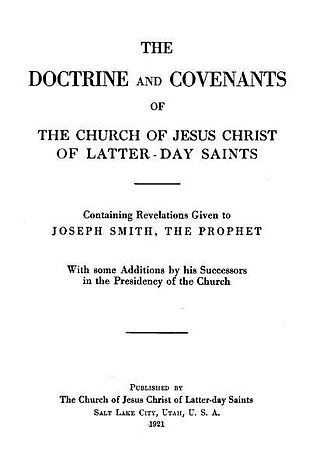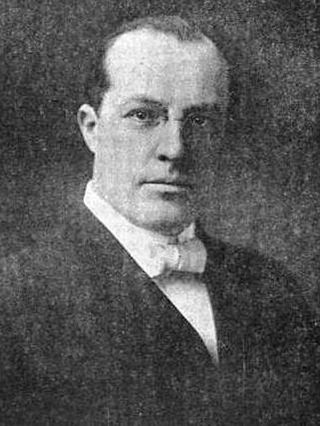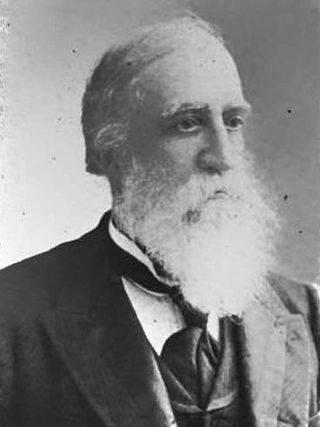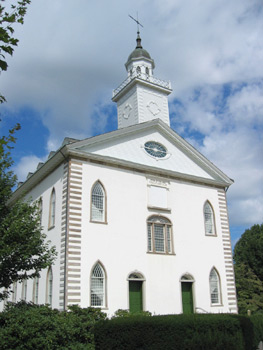
The Doctrine and Covenants is a part of the open scriptural canon of several denominations of the Latter Day Saint movement. Originally published in 1835 as Doctrine and Covenants of the Church of the Latter Day Saints: Carefully Selected from the Revelations of God, editions of the book continue to be printed mainly by the Church of Jesus Christ of Latter-day Saints and the Community of Christ.

The Community of Christ, known from 1872 to 2001 as the Reorganized Church of Jesus Christ of Latter Day Saints (RLDS), is an American-based international church, and is the second-largest denomination in the Latter Day Saint movement. The church reports 250,000 members in 1,100 congregations in 59 countries. The church traces its origins to Joseph Smith's establishment of the Church of Christ on April 6, 1830. His eldest son Joseph Smith III formally accepted leadership of the church on April 6, 1860 in the aftermath of the 1844 death of Joseph Smith.

Frederick Madison Smith, generally known among his followers as "Fred M.", was an American religious leader and author and the third Prophet-President of the Reorganized Church of Jesus Christ of Latter Day Saints, serving from 1915 until his death.
In the Latter Day Saint movement, the President of the Church is generally considered to be the highest office of the church. It was the office held by Joseph Smith, founder of the movement, and the office assumed by many of Smith's claimed successors, such as Brigham Young, Joseph Smith III, Sidney Rigdon, and James Strang. Several other titles have been associated with this office, including First Elder of the church, Presiding High Priest, President of the High Priesthood, Trustee-in-Trust for the church, Prophet, Seer, Revelator, and Translator. Joseph Smith was known by all of these titles in his lifetime.

The Latter Day Saint movement is a religious movement within Christianity that arose during the Second Great Awakening in the early 19th century and that led to the set of doctrines, practices, and cultures called Mormonism, and to the existence of numerous Latter Day Saint churches. Its history is characterized by intense controversy and persecution in reaction to some of the movement's doctrines and practices and their relationship to mainstream Christianity. The purpose of this article is to give an overview of the different groups, beliefs, and denominations that began with the influence of Joseph Smith.

Joseph Smith III was the eldest surviving son of Joseph Smith and Emma Hale Smith. Joseph Smith III was the Prophet-President of what became the Reorganized Church of Jesus Christ of Latter Day Saints, known as the Community of Christ since 2001, which considers itself a continuation of the church established by Smith's father in 1830. For fifty-four years until his own death, Smith presided over the church. Smith's moderate ideas and nature set much of the tone for the church's development, earning him the sobriquet of "the pragmatic prophet".

William Marks was a leader in the early days of the Latter Day Saint movement and was a member of the First Presidency in the Reorganized Church of Jesus Christ of Latter Day Saints. Marks is mentioned in the Doctrine and Covenants in sections 117 and 124 of the Church of Jesus Christ of Latter-day Saints edition and in section 115 of the Community of Christ edition.
Lineal succession was a doctrine of the Latter Day Saint movement, whereby certain key church positions were held by right of lineal inheritance. Though lineal succession is now largely abandoned, the offices connected with the practice were the President of the Church and the Presiding Patriarch.

The Remnant Church of Jesus Christ of Latter Day Saints, usually referred to as the Remnant Church, is a denomination in the Latter Day Saint movement. The prophet / president of the church is Terry W. Patience.

Israel Alexander Smith was the fourth son of Joseph Smith III and a grandson of Joseph Smith Jr., the founder of the Latter Day Saint movement. Israel A. Smith succeeded his brother, Frederick M. Smith, as Prophet-President of the Reorganized Church of Jesus Christ of Latter Day Saints on April 9, 1946.
In the Community of Christ, the Council of Twelve Apostles is one of the governing bodies in the church hierarchy. They are disciples who hold the priesthood office of apostle, and are responsible for the evangelistic witness of the church. Apostles are also high priests in the Melchizedek priesthood of the church.

William Wallace Smith was a grandson of Joseph Smith Jr. and Prophet-President of the Reorganized Church of Jesus Christ of Latter Day Saints, from October 6, 1958, to April 5, 1978, when he retired to "emeritus" status.
In the Latter Day Saint movement, there are two presiding high councils, one said to be "standing," and the other "traveling." The traveling high council is generally known as the Quorum of Twelve Apostles. Both councils, at least in theory, preside over the church, although the apostles have tended to supersede the standing high council in both of the largest Latter Day Saint denominations, The Church of Jesus Christ of Latter-day Saints and the Community of Christ.

Restoration Branches movement is a Christian/Latter Day Saint religious sect which was formed in the 1980s by members of the Reorganized Church of Jesus Christ of Latter Day Saints in a reaction against the events of the RLDS 1984 world conference. The movement holds in the traditional RLDS theology of the 19th and early-to-mid 20th centuries and hold that events leading up to and surrounding the 1980s and decades since have introduced sweeping, fundamental changes into RLDS doctrine and practice which are illegitimate because they contradict the long-standing RLDS theological tradition this sect holds as true. It is also a part of the Mormon religion.

The history of Community of Christ, formerly known as the Reorganized Church of Jesus Christ of Latter Day Saints, covers a period of approximately 200 years. The church's early history traces to the "grove experience" of Joseph Smith, who prayed in the woods near his home in Palmyra, New York, in the early-19th century. Several accounts of this experience have surfaced over the years. Most of the accounts share a common narrative indicating that when he went to the woods to pray, he experienced a period of encountering evil or despair, but then experienced an epiphany or vision in which he came to know and understand God's goodness. Later, as an adult, Smith founded the Church of Christ on April 6, 1830.
Granville Hedrick was a leader in the Latter Day Saint movement after the 1844 succession crisis. In 1863, Hedrick became the founding leader of the Church of Christ, which is one of many churches that claim to be a continuation of the Church of Christ founded by Joseph Smith in 1830.

Richard Charles Evans was a Canadian apostle and member of the First Presidency in the Reorganized Church of Jesus Christ of Latter Day Saints who became the leader of a schismatic sect that separated from the RLDS Church in 1918.

The Temple Lot, located in Independence, Missouri, is the first site to be dedicated for the construction of a temple in the Latter Day Saint movement. The area was dedicated on August 3, 1831, by the movement's founder, Joseph Smith Jr., and purchased on December 19, 1831, by his colleague Edward Partridge to be the center of the New Jerusalem or "City of Zion" after he received a revelation stating that it would be the gathering spot of the Latter Day Saints during the last days.

The Church of Christ (Restored) is a denomination within the Latter Day Saint movement that split from the Church of Christ (Fettingite) in the late 1930s under the leadership of Elder A. C. DeWolf. This schism was provoked by a difference in opinion regarding a series of claimed "messages" received by William Draves, an elder in that church, following the death of founder Otto Fetting. Whereas the main Fettingite church initially chose to grant cautious acceptance to these missives, several Fettingite branches in Louisiana and Mississippi did not, and split from the main organization to form the Church of Christ (Restored). Even after the main Fettingite church chose to reject Draves and his messages in 1943, the DeWolf faction refused to reconcile with the main body, considering itself to be the sole legitimate continuation of the Fettingite church, and the only true church on earth today. Its membership is currently concentrated mostly in the American South, and stands at about 450 members.

The Church of Christ, informally referred to as the Church of Christ (Hancock), the Basement Church, the Church of Christ (Lukeite) and the Church of Christ, was a sect of the Latter Day Saint movement founded in Independence, Missouri in 1946 by Pauline Hancock. This church, which became defunct in 1984, bears the distinction of being the first Latter Day Saint sect to be founded by a woman. Among its members were Jerald and Sandra Tanner, who later became well-known opponents of the Latter Day Saint movement with their "Utah Lighthouse Ministry".















